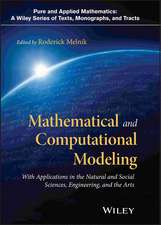Mathematical Modeling of Physical Systems: An Introduction: Engineering & Technology
Autor Diran Basmadjianen Limba Engleză Hardback – dec 2002
Preț: 1478.19 lei
Preț vechi: 2024.91 lei
-27% Nou
Puncte Express: 2217
Preț estimativ în valută:
282.84€ • 296.11$ • 234.04£
282.84€ • 296.11$ • 234.04£
Carte tipărită la comandă
Livrare economică 05-19 aprilie
Preluare comenzi: 021 569.72.76
Specificații
ISBN-13: 9780195153149
ISBN-10: 0195153146
Pagini: 368
Ilustrații: numerous line figures
Dimensiuni: 197 x 245 x 24 mm
Greutate: 0.82 kg
Editura: OXFORD UNIV PR
Colecția Engineering & Technology
Seria Engineering & Technology
Locul publicării:New York, United States
ISBN-10: 0195153146
Pagini: 368
Ilustrații: numerous line figures
Dimensiuni: 197 x 245 x 24 mm
Greutate: 0.82 kg
Editura: OXFORD UNIV PR
Colecția Engineering & Technology
Seria Engineering & Technology
Locul publicării:New York, United States
Descriere
The aim of this text is to provide the beginning student or professional with introduction to the topic in an easily understood student friendly manner. It is based on the premise that modeling is as much art as it is science and that mastering the art can only be achieved by sustained practice. To provide that practice, the text contains some 100 odd worked examples as well as numerous practice problems drawn from variety of disciplines. They range from classicalexamples such as Euler's treatment of the buckling of the strut, to the contemporary topics of silicon chip manufacturing and the dynamics of the human immunodeficiency virus (HIV). Other examples are drawn from mechanical, electrical, chemical and environmental engineering disciplines as well asfrom the fields of economics, physics and chemistry. The mathematics required are confined to simple treatment of vector algebra, matrix operations and the solutions of ordinary differential equations. Both analytical and numerical methods are taken up and are described in sufficient detail to serve as a learning tool for the beginner or as a refresher for the informed reader. The text is designed for 3rd and 4th yr students in all engineering disciplines as well as mathematics, physics and chemistry. It should also serve as a welcome addition to libraries of practicing professionals.













